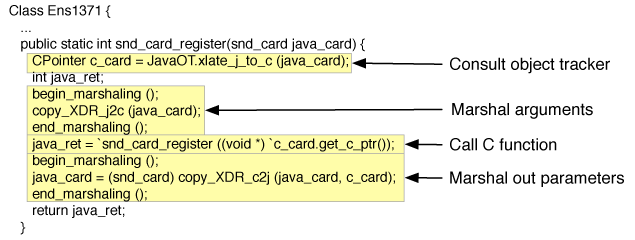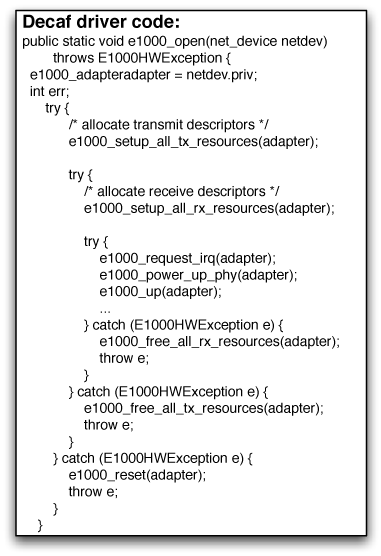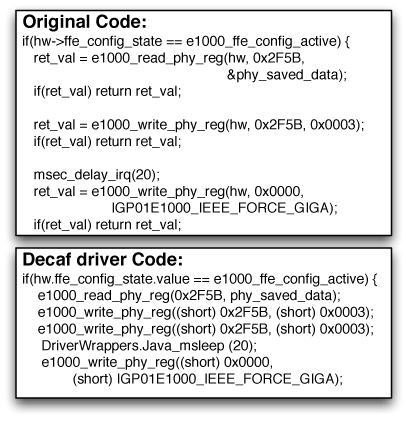



| Source Components | # Lines |
| Runtime support | |
| Jeannie helpers | 1,976 |
| XPC in Decaf runtime | 2,673 |
| XPC in Nuclear runtime | 4,661 |
| DriverSlicer | |
| CIL OCaml | 12,465 |
| Python scripts | 1,276 |
| XDR compilers | 372 |
| Total number of lines of code
| 23,423 |
| Driver | Lines of | DriverSlicer | Driver nucleus | Driver library | Decaf driver | |||||
| Name | Type | code | Annotations | Funcs | LoC | Funcs | LoC | Funcs | LoC | Orig. LoC |
| 8139too | Network | 1,916 | 17 | 12 | 389 | 16 | 292 | 25 | 541 | 570 |
| E1000 | Network | 14,204 | 64 | 46 | 1715 | 0 | 0 | 236 | 7804 | 8693 |
| ens1371 | Sound | 2,165 | 18 | 6 | 140 | 0 | 0 | 59 | 1049 | 1068 |
| uhci-hcd | USB 1.0 | 2,339 | 94 | 68 | 1537 | 12 | 287 | 3 | 188 | 168 |
| psmouse | Mouse | 2,448 | 17 | 15 | 501 | 74 | 1310 | 14 | 192 | 250 |
| Driver | Workload | Relative | CPU Utilization | Init. Latency | User/Kernel | ||
| Name | Performance | native | Decaf | native | Decaf | Crossings | |
| 8139too | netperf-send | 1.00 | 14 % | 13 % | 0.02 sec. | 1.02 sec. | 40 |
| netperf-recv | 1.00 | 17 % | 15 % | - | - | - | |
| E1000 | netperf-send | 0.99 | 2.8 % | 3.7 % | 0.42 sec. | 4.87 sec. | 91 |
| netperf-recv | 1.00 | 20 % | 21 % | - | - | - | |
| ens1371 | mpg123 | - | 0.0 % | 0.1 % | 1.12 sec. | 6.34 sec. | 237 |
| uhci-hcd | tar | 1.03 | 0.1 % | 0.1 % | 1.32 sec. | 2.67 sec | 49 |
| psmouse | move-and-click | - | 0.1 % | 0.1 % | 0.04 sec. | 0.40 sec. | 24 |


| Category | Lines of Code Changed |
| Driver nucleus | 381 |
| Decaf driver | 4690 |
| User/kernel interface | 23 |